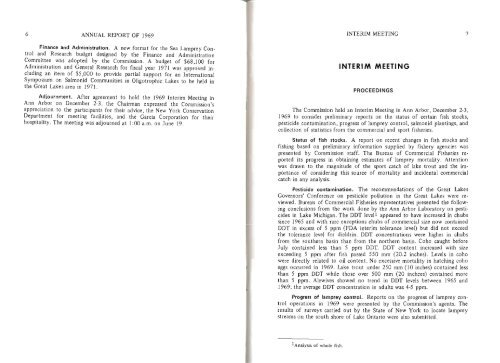You also want an ePaper? Increase the reach of your titles
YUMPU automatically turns print PDFs into web optimized ePapers that Google loves.
6 ANNUAL REPORT OF <strong>1969</strong><br />
INTERIM MEETING<br />
7<br />
Finance and Administration. A new format for the Sea Lamprey Control<br />
and Research budget designed by the Finance and Administration<br />
Committee was adopted by the <strong>Commission</strong>. A budget of $68,100 for<br />
Administration and General Research for fiscal year 1971 was approved including<br />
an item of $5,000 to provide partial support for an International<br />
Symposium on Salmonid Communities in Oligotrophic <strong>Lakes</strong> to be held in<br />
the <strong>Great</strong> <strong>Lakes</strong> area in 1971.<br />
Adjournment. After agreement to hold the <strong>1969</strong> Interim Meeting in<br />
Ann Arbor on December 2-3, the Chairman expressed the <strong>Commission</strong>'s<br />
appreciation to the participants for their advice, the New York Conservation<br />
Department for meeting facilities, and the Garcia Corporation for their<br />
hospitality. The meeting was adjourned at 1:00 a.m. on June 19.<br />
INTERIM MEETING<br />
PROCEEDINGS<br />
The <strong>Commission</strong> held an Interim Meeting in Ann Arbor, December 2-3,<br />
<strong>1969</strong> to consider preliminary reports on the status of certain fish stocks,<br />
pesticide contamination, progress of lamprey control, salmonid plantings, and<br />
collection of statistics from the commercial and sport fisheries.<br />
Status of fish stocks. A report on recent changes in fish stocks and<br />
fishing based on preliminary information supplied by fishery agencies was<br />
presented by <strong>Commission</strong> staff. The Bureau of Commercial Fisheries reported<br />
its progress in obtaining estimates of lamprey mortality. Attention<br />
was drawn to the magnitude of the sport catch of lake trout and the importance<br />
of considering this source of mortality and incidental commercial<br />
catch in any analysis.<br />
Pesticide contamination. The recommendations of the <strong>Great</strong> <strong>Lakes</strong><br />
Governors' Conference on pesticide pollution in the <strong>Great</strong> <strong>Lakes</strong> were reviewed.<br />
Bureau of Commercial Fisheries representatives presented the following<br />
conclusions from the work done by the Ann Arbor Laboratory on pesticides<br />
in Lake Michigan. The DDT levell appeared to have increased in chubs<br />
since 1965 and with rare exceptions chubs of commercial size now contained<br />
DDT in excess of 5 ppm (FDA interim tolerance level) but did not exceed<br />
the tolerance level for dieldrin. DDT concentrations were higher in chubs<br />
from the southern basin than from the northern basin. Coho caught before<br />
July contained less than 5 ppm DDT. DDT content increased with size<br />
exceeding 5 ppm after fish passed 550 mm (20.2 inches). Levels in coho<br />
were directly related to oil content. No excessive mortality in hatching coho<br />
eggs occurred in <strong>1969</strong>. Lake trout under 250 mm (10 inches) contained less<br />
than 5 ppm DDT while those over 500 mm (20 inchees) contained more<br />
than 5 ppm. Alewives showed no trend in DDT levels between 1965 and<br />
<strong>1969</strong>; the average DDT concentration in adults was 4-5 ppm.<br />
Progress of lamprey control. Reports on the progress of lamprey control<br />
operations in <strong>1969</strong> were presented by the <strong>Commission</strong>'s agents. The<br />
results of surveys carried out by the State of New York to locate lamprey<br />
streams on the south shore of Lake Ontario were also submitted.<br />
1Analysis of whole fish.
















